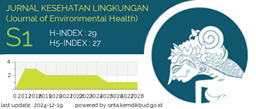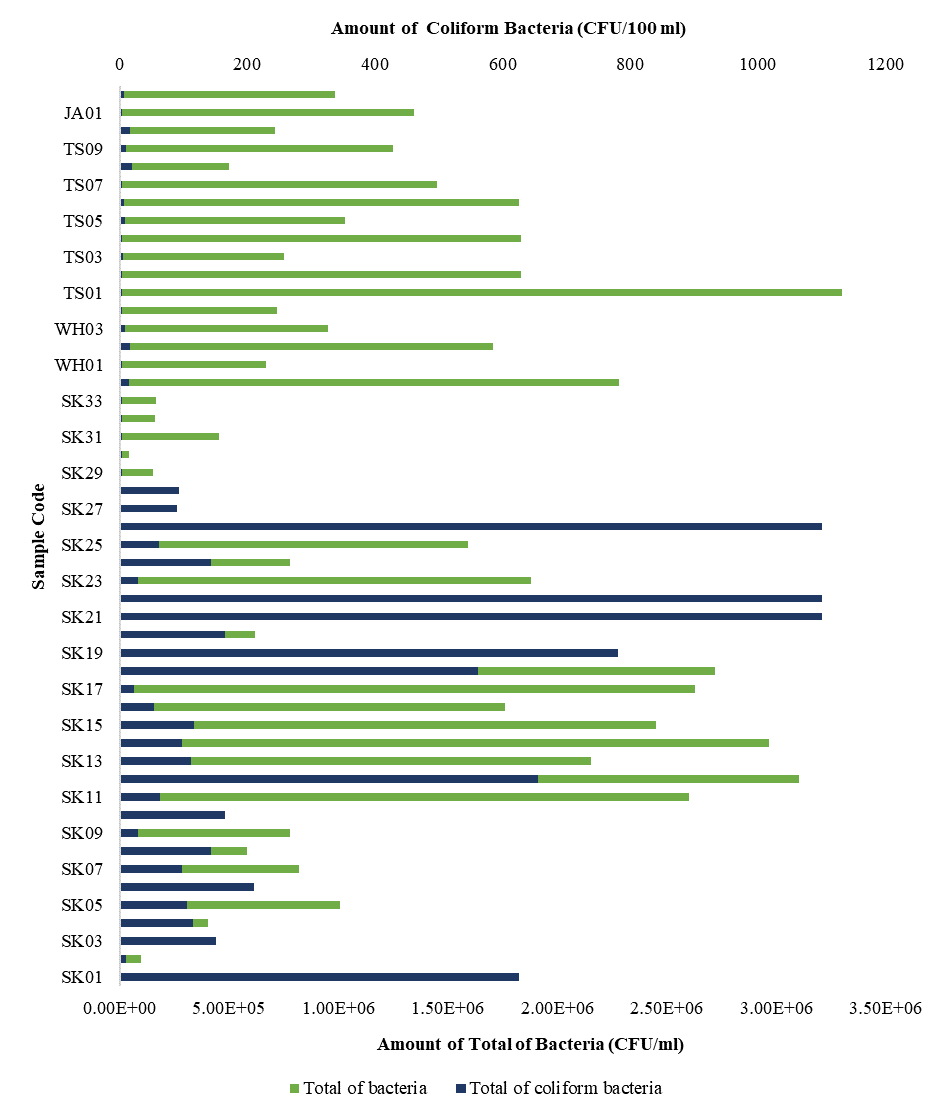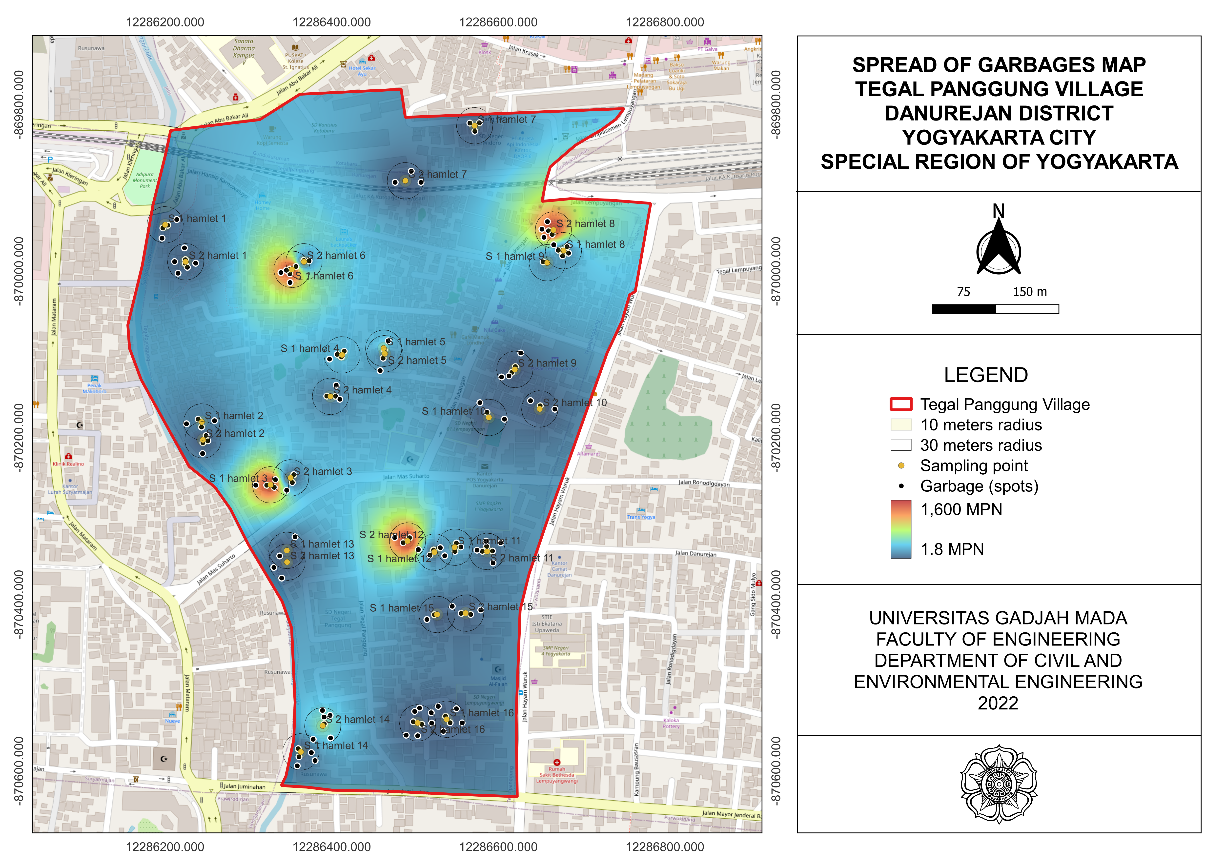Impact of Climate Change on Dengue Hemorrhagic Fever (DHF) in Tropical Countries: A Literature Review
Downloads
Tran BL, Tseng WC, Chen CC, Liao SY. Estimating the Threshold Effects of Climate on Dengue: A Case Study of Taiwan. Int J Environ Res Public Health. 2020;17(4):1–17. https://doi.org/10.3390/ijerph17041392
Cucunawangsih, Lugito NPH. Trends of Dengue Disease Epidemiology. Virology. 2017;8(1):1-6. https://doi.org/10.1177/1178122X17695836
World Health Organization. Dengue and severe dengue. Geneve: World Health Organization; 2021 https://www.who.int/news-room/fact-sheets/detail/dengue-and-severe-dengue
Samal RR, Gupta S, Kumar S. An Overview of Factors Affecting Dengue Transmission in Asian Region and Its Predictive Models. J Appl Nat Sci. 2020;12(3):460–470. https://doi.org/10.31018/jans.v12i3.2360
Jing QL, Cheng Q, Marshall JM, Hu WB, Yang ZC, Lu JH. Imported Cases and Minimum Temperature Drive Dengue Transmission in Guangzhou, China: Evidence from ARIMAX model. Epidemiology and Infection. 2018;146(10):1226–1235. https://doi.org/10.1017/S0950268818001176
Satoto TBT, Alvira N, Wibawa T, Diptyanusa A. Controlling Factors that Potentially Against Transmission of Dengue Hemorrhagic Fever at State Elementary Schools in Yogyakarta. Kesmas. 2017;11(4):178–184. http://dx.doi.org/10.21109/kesmas.v11i4.1248
Mordecai EA, Cohen JM, Evans M V, Gudapati P, Johnson LR, Lippi CA, et al. Detecting the Impact of Temperature on Transmission of Zika, Dengue, and Chikungunya Using Mechanistic Models. PLoS Negl Trop Dis. 2017;11(4):1–18. https://doi.org/10.1371/journal.pntd.0005568
Ogden NH, Lindsay LR. Effects of Climate and Climate Change on Vectors and Vector-Borne Diseases: Ticks Are Different. Trends Parasitol. 2016;32(8):646–656. http://dx.doi.org/10.1016/j.pt.2016.04.015
National Geographic Society. Climate Change. Washington: National Geographic Society. https://www.nationalgeographic.org/encyclopedia/climate-change/
Intergovernmental Panel on Climate Change (IPCC). Special Report on Climate Change and Land. Geneva: Intergovernmental Panel on Climate Change; 2019. https://www.ipcc.ch/srccl/
Intergovernmental Panel on Climate Change (IPCC). Technical Summary: Special Report on Climate Change and Land. Geneva: Intergovernmental Panel on Climate Change; 2019. https://www.ipcc.ch/srccl/chapter/technical-summary/
World Health Organization. Climate Change and Health. Geneva: World Health Organization; 2018. https://www.who.int/news-room/fact-sheets/detail/climate-change-and-health
de Vries S, Snep R. Biodiversity in the Context of ‘Biodiversity – Mental Health' Research. Biodiversity and Health in the Face of Climate Change. Switzerland: Springer Cham; 2019. 159–173 p. https://doi.org/10.1007/978-3-030-02318-8_8
Caminade C, McIntyre KM, Jones AE. Impact of Recent and Future Climate Change on Vector-Borne Diseases. Ann N Y Acad Sci. 2019;1436(1):157–173. https://doi.org/10.1111/nyas.13950
Iwamura T, Guzman-Holst A, Murray KA. Accelerating Invasion Potential of Disease Vector Aedes Aegypti Under Climate Change. Nat Commun. 2020;11(2130):1-10. http://dx.doi.org/10.1038/s41467-020-16010-4
Aadil Gulzar, Tajamul Islam, Ruquia Gulzar, Tabasum Hassan. Climate Change and Impacts of Extreme Events on Human Health: An Overview. Indones J Soc Environ Issues. 2021;2(1):68–77. https://doi.org/10.47540/ijsei.v2i1.180
Ishak NI, Kasman K. the Effect of Climate Factors for Dengue Hemorrhagic Fever in Banjarmasin City, South Kalimantan Province, Indonesia, 2012-2016. Public Heal Indones. 2018;4(3):121–128. http://dx.doi.org/10.36685/phi.v4i3.181
Davis C, Murphy AK, Bambrick H, Devine GJ, Frentiu FD, Yakob L, et al. A Regional Suitable Conditions Index to Forecast The Impact of Climate Change on Dengue Vectorial Capacity. Environ Res. 2021;195(110849):1-9. https://doi.org/10.1016/j.envres.2021.110849
Madeleine CT, Simon JM. Climate Information For Public Health Action. Routledge: Climate Information For Public Health Action; 2018. https://www.taylorfrancis.com/books/oa-edit/10.4324/9781315115603/climate-information-public-health-action-thomson-madeleine-mason-simon
Mutheneni SR, Morse AP, Caminade C, Upadhyayula SM. Dengue Burden in India: Recent Trends and Importance of Climatic Parameters. Emerg Microbes Infect. 2017;6(1):1-10. http://dx.doi.org/10.1038/emi.2017.57
Nosrat C, Altamirano J, Anyamba A, Caldwell JM, Damoah R, Mutuku F, et al. Impact of Recent Climate Extremes on Mosquito-Borne Disease Transmission in Kenya. PLoS Negl Trop Dis. 2021;15(3):1–17. http://dx.doi.org/10.1371/journal.pntd.0009182
Ebi KL, Nealon J. Dengue in A Changing Climate. Environ Res. 2016;151(1):115–123. http://dx.doi.org/10.1016/j.envres.2016.07.026
Kesetyaningsih TW, Fauzan RA. The Relationship Between Climate Factors and Dengue Hemorrhagic Fever Incidence in Sleman , Yogyakarta. 4th Int Conf Sustain Innov 2020–Health Sci Nurs. 2021;33(1):614-619. https://doi.org/10.2991/ahsr.k.210115.116
Sun H, Jit M, Cook AR, Carrasco LR, Dickens BL. Determining Environmental and Anthropogenic Factors Which Explain the Global Distribution of Aedes Aegypti and Ae. Albopictus. BMJ Glob Heal. 2018;3(4):1–11. http://dx.doi.org/10.1136/bmjgh-2018-000801
Helmersson JL. Climate Change, Dengue and Aedes Mosquitoes: Past Trends and Future Scenarios. Dissertation. Sweden: Umea University. 2018. http://urn.kb.se/resolve?urn=urn:nbn:se:umu:diva-143764
Portilla Cabrera CV, Selvaraj JJ. Geographic Shifts in The Bioclimatic Suitability for Aedes Aegypti Under Climate Change Scenarios in Colombia. Heliyon. 2020;6(1):e03101. https://doi.org/10.1016/j.heliyon.2019.e03101
Sintayehu DW, Tassie N, De Boer WF. Present and Future Climatic Suitability for Dengue Fever in Africa. Infect Ecol Epidemiol. 2020;10(1). https://doi.org/10.1080/20008686.2020.1782042
Hasanah H, Susanna D. Weather Implication for Dengue Fever in Jakarta, Indonesia 2008-2016. KnE Life Sci. 2019;4(10):184-192. https://doi.org/10.18502/kls.v4i10.3719
Hashem AM, Abujamel T, Alhabbab R, Almazroui M, Azhar EI. Dengue Infection in Patients with Febrile Illness and Its Relationship to Climate Factors: A Case Study in The City of Jeddah, Saudi Arabia, for the period 2010–2014. Acta Trop. 2018;181(1):105–111. https://doi.org/10.1016/j.actatropica.2018.02.014
Komaling D, Sumampouw OJ, Sondakh RC, Kesehatan F, Universitas M, Ratulangi S. Determinan Kejadian Demam Berdarah Dengue di Kabupaten Minahasa Selatan Tahun 2016-2018. J Public Heal Community Med. 2020;1(1):57–64.
https://doi.org/10.35801/ijphcm.1.1.2020.27247
Chadee DD, Martinez R. Aedes aegypti (L.) in Latin American and Caribbean Region: With Growing Evidence for Vector Adaptation to Climate Change?. Acta Trop. 2016;156(1):137–143. http://dx.doi.org/10.1016/j.actatropica.2015.12.022
Sukiato F, Wasserman RJ, Foo SC, Wilson RF, Cuthbert RN. The Effects of Temperature and Shading on Mortality and Development Rates of Aedes Aegypti (Diptera: Culicidae). J Vector Ecol. 2019;44(2):264–270. https://doi.org/10.1111/jvec.12358
Liu-Helmersson J, Quam M, Wilder-Smith A, Stenlund H, Ebi K, Massad E, et al. Climate Change and Aedes Vectors: 21st Century Projections for Dengue Transmission in Europe. EBioMedicine. 2016;7(1):267–277. http://dx.doi.org/10.1016/j.ebiom.2016.03.046
Arcari P, Tapper N. The Variable Impact of ENSO Events on Regional Dengue/DHF in Indonesia. Singap J Trop Geogr. 2017;38(1):5–24. https://doi.org/10.1111/sjtg.12179
Pasin C, Halloran ME, Gilbert PB, Langevin E, Ochiai RL, Pitisuttithum P, et al. Periods of High Dengue Transmission Defined by Rainfall Do Not Impact Efficacy of Dengue Vaccine in Regions of Endemic Disease. PLoS One. 2018;13(12):1–16. https://doi.org/10.1371/journal. pone.0207878
Ahmad R, Suzilah I, Najdah WMAW, Topek O, Mustafakamal I, Lee HL. Factors Determining Dengue Outbreak in Malaysia. PLoS One. 2018;13(2):1–13. https://doi.org/10.1371/ journal.pone.0193326
Iguchi JA, Seposo XT, Honda Y. Meteorological Factors Affecting Dengue Incidence in Davao, Philippines. BMC Public Health. 2018;18(1):1–10. https://doi.org/10.1186/s12889-018-5532-4
Kakarla SG, Bhimala KR, Kadiri MR, Kumaraswamy S, Mutheneni SR. Dengue Situation in India: Suitability and Transmission Potential Model for Present and Projected Climate Change Scenarios. Sci Total Environ. 2020;739(140336):1-12. https://doi.org/10.1016/j.scitotenv.2020.140336
Ghaisani NP, Lucia M, Lusida I. Correlation between Climate Factors with Dengue Hemorrhagic Fever Cases in Surabaya 2007 – 2017. Indonesian Journal of Tropical and Infectious Disease. 2021;9(1):39-44. http://dx.doi.org/10.20473/ijtid.v9i1.16075
Lai YH. The Climatic Factors Affecting Dengue Fever Outbreaks in Southern Taiwan: An Application of Symbolic Data Analysis. Biomed Eng Online. 2018;17(S2):1–14. https://doi.org/10.1186/s12938-018-0575-4
Davis RE, McGregor GR, Enfield KB. Humidity: A Review and Primer on Atmospheric Moisture and Human Health. Environ Res. 2016;144(1):106–116. http://dx.doi.org/10.1016/j.envres.2015.10.014
Putri WA, Rohiman A, Sulistiawati S, Puspitasari D. Effects of Climatic Factors on The Incidence Rate of Dengue Virus Infection in Surabaya During 2010-2013. Biomol Heal Sci J. 2019;2(1):36-40. http://dx.doi.org/10.20473/bhsj.v2i1.9340
Xiao J, Liu T, Lin H, Zhu G, Zeng W, Li X, et al. Weather Variables and the El Niño Southern Oscillation May Drive the Epidemics of Dengue in Guangdong Province, China. Sci Total Environ. 2018;624(1):926–934. https://doi.org/10.1016/j.scitotenv.2017.12.200
Pol SS, Rajderkar SS, Dhabekar PD, Bansode Gokhe SS. Effect of Climatic Factors Like Rainfall, Humidity and Temperature on The Dengue Cases in The Metropolitan City of Maharashtra. Int J Community Med Public Heal. 2021;8(2):672-677. https://dx.doi.org/10.18203/2394-6040.ijcmph20210220
Alizkan U. Analisis Korelasi Kelembaban Udara Terhadap Epidemi Demam Berdarah yang Terjadi di Kabupaten dan Kota Serang. Gravity. 2017;3(1):23–29. http://dx.doi.org/10.30870/gravity.v3i1.2409
Arieskha FTA, Rahardjo M, Joko T. The Association between Weather Variability and Dengue Hemorrhagic Fever in Tegal Regency. J Kesehat Lingkung. 2019;11(4):339-347. http://dx.doi.org/10.20473/jkl.v11i4.2019.339-347
Haikerwal A, Saxena SK. Impact of Climate Change on Water-Associated Infectious Diseases. Brazilian Arvhives of Biology and Technology. 2019;64(1):53–62. https://doi.org/10.1590/1678-4324-2021190502
Butterworth MK, Morin CW, Comrie AC. An Analysis Of The Potential Impact Of Climate Change On Dengue Transmission In The Southeastern United States. Environ Health Perspect. 2017;125(4):579–585. https://doi.org/10.1289/EHP218
Messina JP, Brady OJ, Golding N, Kraemer MUG, Wint GRW, Ray SE, et al. The Current and Future Global Distribution and Population at Risk of Dengue. Nat Microbiol. 2019;4(9):1508–15015. http://dx.doi.org/10.1038/s41564-019-0476-8
Mweya CN, Kimera SI, Stanley G, Misinzo G, Mboera LEG. Climate Change Influences Potential Distribution of Infected Aedes Aegypti Co-Occurrence with Dengue Epidemics Risk Areas in Tanzania. PLoS One. 2016;11(9):1–13. https://doi.org/10.1371/journal.pone.0162649
Fatmawati F, Sulistyawati S. Climate Change and Dengue in Indonesia: a Systematic Review. Epidemiol Soc Heal Rev. 2019;1(1):29-40. https://doi.org/10.26555/eshr.v1i1.938
Acharya BK, Cao C, Xu M, Khanal L, Naeem S, Pandit S. Present and Future of Dengue Fever in Nepal: Mapping Climatic Suitability by Ecological Niche Model. Int J Environ Res Public Health. 2018;15(2):1-15. https://doi.org/10.3390/ijerph15020187
2. Formal legal provisions to access digital articles of electronic journal are subject to the provision of the Creative Commons Attribution-ShareAlike license (CC BY-NC-SA), which means that Jurnal Kesehatan Lingkungan is rightful to keep, transfer media/format, manage in the form of databases, maintain, and publish articles.
3. Published manuscripts both printed and electronic are open access for educational, research, and library purposes. Additionally, the editorial board is not responsible for any violations of copyright law.
JKESLING by UNAIR is licensed under a Creative Commons Attribution-ShareAlike 4.0 International License.







































